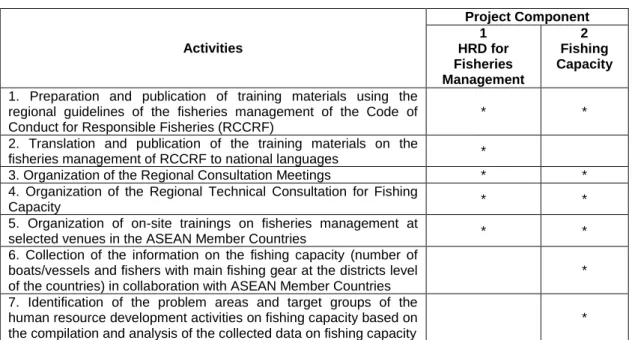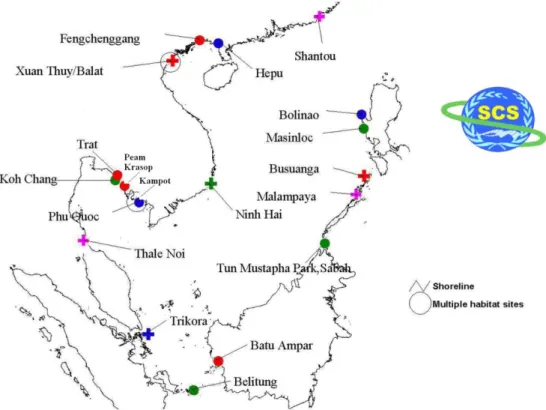Project Final Report: The SEAFDEC-Sida Collaborative Project on “Human Resource Development to Support the Implementation of the Code of Conduct for Responsible Fisheries Management for the ASEAN Region” was prepared by the Secretariat of the Southeast Asian Fisheries Development Center (SEAFDEC). SEAFDEC-Sida Collaborative Project on “Human Resource Development on the Support of Implementation of the Code of Conduct for Responsible Fisheries Management for the ASEAN Region”, 2007. RCCRF Regionalization of the Code of Conduct for Responsible Fisheries RIDNIC-HRD Regional Inventory, Database and Network for information.
Human Resource Development to Support the Implementation of the Code of Conduct for Responsible Fisheries Management for the ASEAN Region”.
Introduction and Rationale
- Development Objectives
- Goals and Objectives
- Nature and Scope of Project/Activities
- Project Organization and Funding
Consultations and review meetings help to establish ownership of the project among ASEAN member states. Collection of information on fishing capacity (number of boats/vessels and fishermen using the main fishing gear at the district level of the countries) in cooperation with ASEAN Member States. Preparation and publication of the required training materials (specific and detailed training materials) on fishing capacity limitation.
Preparation and publication of the required training materials (specific and detailed training materials) on mitigation of fishing capacity (in progress).

Outcomes and Results
Process Oriented Results
- Specifics on the Training/Learning Aspect of the Pilot Process
- Towards the Establishment of a Regional Fisheries Management Body…24
- HRD: Specific to the Management of Fishing Capacity in Southeast Asia…27
- Cross-cutting Issues
- Social Concerns
- Environmental Concerns
- Health Concerns
- Poverty
- Legal and Institutional Concerns
- Civil Society/ NGO’s
- Capacity Building
A summary of the findings and recommendations for human rights defenders, for fisheries management and for the need to address fishing capacity emerging from the regional technical consultations are provided in Chapter 4 of this report. As for the on-site training in Lombok Timur, it was intended that this would be supported by the project as part of the pilot process. Organization of the on-site training on capacity building for coastal resource management in Trang Province, Thailand, March 14 - 16, 2006 (42 participants).
The planning meeting also recognized the relevance of the three "thematic" features identified by the RTCs, namely: a) Management of excess fishing capacity; b) Strengthening local fisheries management capacity. Organization of the preparatory expert meeting on fisheries capacity and related HRD needs in the ASEAN region, Bangkok, September 2004. Organization/implementation of the "pilot process" in the representative set of countries, namely Cambodia, Indonesia, Thailand and Vietnam, during years.
Specific Results
- Packages of Training Materials
- Database/Network for Information Collection on HRD Activities
- Study on Eco-labelling of Aquatic Products
In the early days of the project, there was a full "Regional Fisheries Policy Working Group". Increased awareness of the necessity of appropriate fisheries management to achieve sustainable development (central + local). Preparation of public training materials using regional fisheries management guidelines (Article 7) of the Code of Conduct for Responsible Fisheries and distribution to Member States.
Organization of the Advisory Project Committee to review the project activities under the SEAFDEC Program Committee. Regional collection of information on fishing capacity (number of boats/vessels and fishermen with main gear at district level in the countries) in collaboration with ASEAN member countries. Regional collection of information on fishing capacity (number of boats/vessels and fishermen with main fishing gear at district level in countries) Component 2.
Formulating the pilot project to raise awareness of fishing capacity issues. Completion of the human resource development program for (methodologies and planning) RCCRF fisheries management at the national level, and required follow-up activities. Organization of on-site training to test the applicability of the regional training materials to RCCRF fisheries management.
Modification of trial-based training materials and finalization and publication of RCCRF fisheries management training materials. Regionalization of the Code of Conduct for Responsible Fishing (Secretariat in cooperation with all departments).
Opportunities, Constraints and Problems
Discussion and Synthesis of Lessons Learned from Project Implementations
Major Lessons Learned and Experiences to be Shared
These aspects were also emphasized during the development of the regional HRD strategy for fisheries management - with the co-support of the project. Learning from a "pilot process" to raise awareness of the need for appropriate fisheries management and to alleviate problems caused by overfishing capacity. The pilot process has proven to be a practical approach to developing and promoting the development of human resources in fisheries management and the management of excess fishing capacity.
For this reason, project benefits from the participation of project staff in other related projects/initiatives14 have been seen in opportunities to convey experiences and results directly to other dialogues, as well as benefits in terms of facilitating and promoting collaborative work with other relevant. agencies on issues related to fisheries management and management of fishing capacity. HRD for fisheries management of fishing capacity should be included in the context of fisheries management as such, thus avoiding. From a fisheries management perspective, you can't really address fisheries management without addressing fishing capacity.
Raise awareness through HRD programs by building on existing training materials and resource persons available in the country. When translating CCRF and RCCRF and other texts such as conventions for national languages to support awareness building at national and local levels, the emphasis should be on "getting the message across" to the audience, not direct translation. Improvement and better planning and management of fisheries: based on recommendations defined by ASEAN-SEAFDEC member countries, one of the main challenges for future improvement of planning and management of coastal fisheries through capacity building and HRD programs is to package policy and technical advice and awareness building for policy makers/high-level officials in fisheries management, including management of fishing capacity.
Seeking broader partnership and cooperation in creating plans and frameworks for human rights defenders in fisheries management: During the process of developing plans and frameworks for human rights defenders in fisheries management since 2004, through the ASEAN-SEAFDEC regional consultation process, it became clear during the implementation process. For longer-term results, it is crucial that broad cooperation is pursued, including beyond the sphere of fisheries agencies. Establishing a partnership between the involved institutions: During the project implementation, active participation of the project staff in SEAFDEC and non-SEAFDEC relevant events/activities was carried out to maintain dialogue with the countries and cooperation projects/initiatives on the issue hold. to fishing.
Management of Fishing Capacity in Southeast Asia
The role of the MPA/refuge in ensuring sustainable fisheries and to determine levels of active fishing capacity at certain times of the year. Managing transboundary fisheries: how to bring countries together to manage these together (Straits of Malacca, Gulf of Thailand) and provide a forum to discuss management of fishing capacity together. Increased demand for fish (direct consumption and processing/export) and impacts on fishing capacity levels.
Status of HRD for Fisheries Management in Southeast Asia
Unclear institutional arrangement and weak institutional capacity for coastal fisheries management, especially at local level. Disorganized policies for the development and management of coastal resource use and weak translation of policies into action.
Recommendations
Management of Fishing Capacity
HRD for Fisheries Management and Fisheries Management
This includes identifying management actions to reduce fishing capacity (especially in destructive fishing) and supplementary/alternative livelihoods (aquaculture, tourism, agribusiness, etc.). Raise awareness to ensure political will and clarify approaches and practical steps in managing excess fishing capacity at the national level. As a practical approach to develop/promote the management of excess fishing capacity, highlighting good examples and encouraging promising pilot activities in selected areas/locations in the region as a basis for exchange of experience at regional level and ongoing national management of fishing capacity.
To facilitate the exit in reducing excess fishing capacity, human rights defenders supporting complementary/alternative livelihoods (in other sectors) should be developed and implemented. Ability to develop criteria for 'fishing capacity', to develop indicators, and criteria for rights-based fishing systems. Packaging policy and technical advice and awareness raising for policy makers/senior officials in the field of fisheries management, including fishing capacity management.
Policy frameworks for the sustainable development and management of coastal fisheries should be developed as a basis for action to be taken at the provincial and local levels, as well as for seeking external project assistance and funding support. If there is too much fishing capacity, an exit scheme from the fishing sector can be considered, but only with due date. Fisheries should be integrated into the sustainable development and management of coastal areas, which can be considered a long-term process.
Management and conservation of coastal resources, including endangered species, should be incorporated into the overall coastal development and management plan. Coastal resource management objectives and strategy of the agencies concerned should be linked and streamlined.
Future Directions and Challenges
Improve the management of fisheries resources through effective implementation and regional application of the Code of Conduct for Responsible Fisheries. Year 4: Organization of the final project advisory committee to review and evaluate the project activities. Organization of the Final Project Advisory Committee to review and evaluate the project activities under the SEAFDEC Program Committee.
Compilation in the digitized atlas and analysis (including field visits to the identified areas) of the collected data on fishing capacity and preparation and publication of the required training material (specific and detailed training material) on mitigating the problems caused by the excessive fishing capacity. Organization of the Regional Technical Consultation for Fishing Capacity (May 2004) In addition to the human resource development activities on the fisheries management, specific activities on the fishing capacity will be started. Finalization of the pilot projects on human resource development on fishing capacity (inputs, methodologies) - Cooperation mechanism with recipient countries.
Based on the outcomes of the group discussion, criteria should be developed that consider the reduction of inequalities between member states. In the deltas of the Mekong and Red River there is also a rich freshwater fishery. Progress of the development is expected to provide useful experiences to the region.
The four HRDs proposed "packages" based on a pilot process in each of the four countries. Countries participating in the fisheries component of the UNEP/GEF project include Cambodia, Indonesia, the Philippines, Thailand and Vietnam. The committee will consist of representatives from participating agencies, donors, ASEAN Member States and SEAFDEC.

